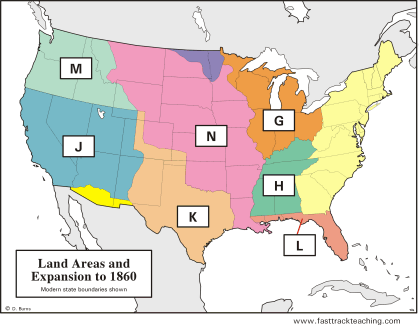| Section 4: The
Growing Years Practice Test
4A
Write your answer choices on a piece of paper, then
click on the "Answer Key" button at the end to check and grade your
test. 1. What belief below is described by the phrase “Manifest Destiny,” as that phrase was used in the early 1800s? A. The nation should make itself an example to the
rest of the world. 2. What was the impact of the cotton gin on slavery in the Southern states? A. It greatly reduced the overall demand for
slaves in the South. 3. Which president was responsible for pushing the United States to obtain the area called the Louisiana Purchase? A. George Washington 4. Where did the explorers Lewis and Clark go on their famous trip to the West? A. along the Santa Fe trail to what is now
southern California 5. Which of these is NOT true of The War of 1812? A. It was fought against Great Britain. 6. Which of these lists best describes the technological developments in the “Transportation Revolution” of 1800-1860 in the United States? A. better roads, canals, steamboats, and steam
railroads 7. Daniel Boone is best known for promoting the settlement of which two present day states? A. Michigan and Ohio 8. The Industrial Revolution in America had its first and largest impact in which geographical area of the country? A. the North 9. Andrew Jackson’s presidency - the “Age of Jackson” - is famous in American history for: A. steadily improving relations with Native
Americans (Indians) 10. The National Road was built by the federal government to improve transportation: A. from Maryland west to the Ohio River and the
area that today is called the Midwest 11. Where is the famous geographical feature called the Cumberland Gap that played such an important role in the westward expansion of the U.S.? A. in the western part of New York State, between
Lake Erie and Lake Ontario
Use the map shown here to answer questions 12 through 15
A. The Old Northwest 13. How was the land area marked N obtained by the U.S.? A. It was purchased from Mexico after the Mexican
War. 14. How did the area marked L become part of the U.S.? A. It was purchased from Mexico in the early
1800s. 15. Which area on the map is known to historians as the Mexican Cession? A. the area marked J 16. What bodies of water were directly connected by the Erie Canal when it opened in 1825? A. Lake Erie and the Hudson River 17. The Oregon Trail ended near present day Portland. Which city below is usually considered its starting point? A. Santa Fe, New Mexico 18. What river forms the southern border of Texas? A. the Snake River 19. When was the California Gold Rush? A. 1814 20. What was the “Trail of Tears”? A. another name for the Natchez Trace
|
